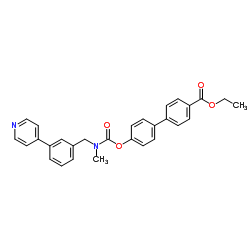| Description |
WWL113 is a selective and orally active Ces3 and Ces1f inhibitor, with IC50 values of 120 nM and 100 nM for Ces3 and Ces1f, respectively. WWL113 appears to show excellent selectivity for the 60-kDa serine hydrolase (or hydrolases)[1].
|
| Related Catalog |
|
| Target |
IC50: 120 nM (Ces3), 100 nM (Ces1f)[1].
|
| In Vitro |
Ces3 and Ces1f are endoplasmic reticulum glycoproteins that have been previously associated with adipocyte lipolysis. WWL113 inhibits mouse recombinant Ces1, Ces1c, and ABHD6 at 10 μM[1]. WWL113 (1 μM) significantly increases UCP1 protein expression in brown adipocytes[2]. WWL113 has a partial, statistically significant inhibitory effect on blocking the buildup of PGE2[3].
|
| In Vivo |
WWL113 (30 mg/kg, orally once a day) results in major improvement of multiple features of metabolic syndrome and ameliorated obesity-diabetes in mice with lowered levels of nonesterified free fatty acids (NEFAs), triglycerides (TGs), total cholesterol and fasted glucose as well as enhanced glucose tolerance[1]. WWL113 ameliorates obesity-diabetes in mice[1]. Animal Model: Eight-week-old db/db mice (n = 10 per group)[1]. Dosage: 30 mg/kg. Administration: Orally once a day for 3 weeks. Result: Corrected multiple features of metabolic syndrome in db/db mice.
|
| References |
[1]. Dominguez, E., Galmozzi, A., Chang, J.W., et al. Integrated phenotypic and activity-based profiling links Ces3 to obesity and diabetes. Nat. Chem. Biol. 10(2), 113-121 (2014). [2]. Galmozzi, et al. ThermoMouse: an in vivo model to identify modulators of UCP1 expression in brown adipose tissue. Cell Rep. 2014 Dec 11;9(5):1584-1593. [3]. Turcotte C, et al. The Endocannabinoid Metabolite Prostaglandin E2 (PGE2)-Glycerol Inhibits Human Neutrophil Functions: Involvement of Its Hydrolysis into PGE2 and EP Receptors. J Immunol. 2017 Apr 15;198(8):3255-3263.
|
